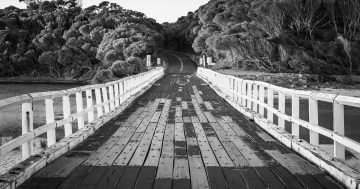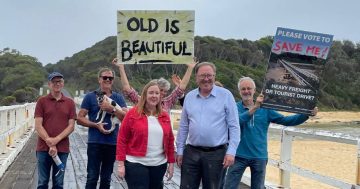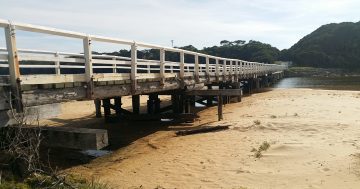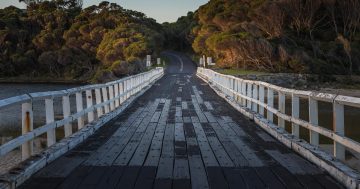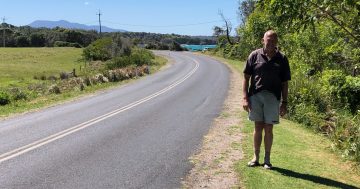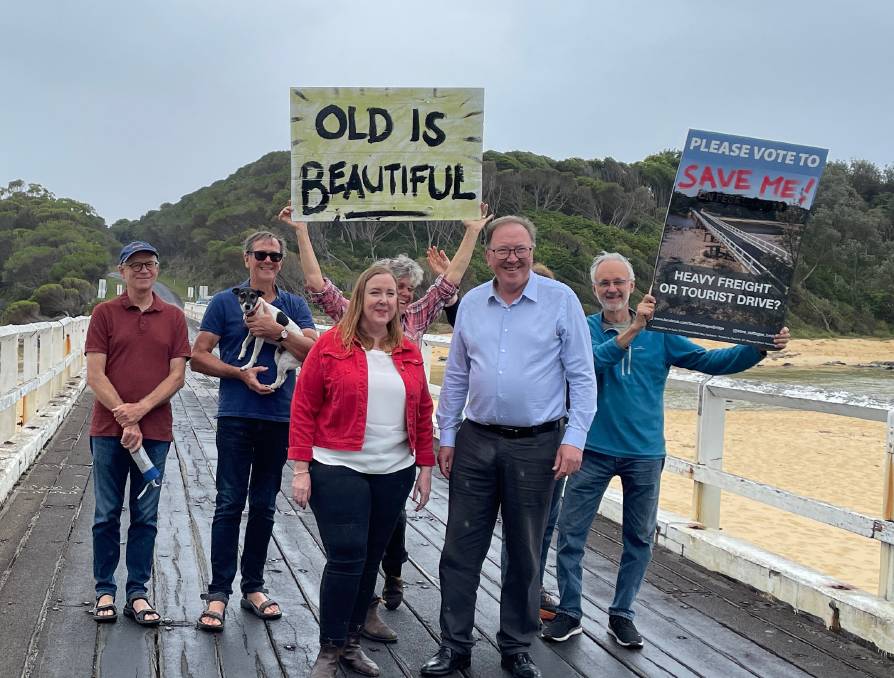
NSW Minister for Regional Transport and Roads Jenny Aitchison and Member for Bega Dr Michael Holland with supporters of restoring Cuttagee Bridge in line with heritage principles. Photo: Marion Williams.
An internationally renowned heritage expert says that none of the design proposals for replacing Cuttagee Bridge provide an appropriate heritage outcome.
Professor Richard Mackay AM has worked in cultural heritage and planning in Australia for more than 40 years. The current NSW Heritage Assessment criteria are derived from seminal work he undertook in the 1990s. The former member of the NSW Heritage Council has been an expert adviser to the UNESCO World Heritage Committee on behalf of the International Council on Monuments and Sites (ICOMOS) since 2015.
The Save Cuttagee Bridge group commissioned Professor Mackay to provide a professional opinion of the three design options that Bega Valley Shire Council has put forward to replace Cuttagee Bridge, 7.7 km south of Bermagui.
On 12 November Bega Valley Shire’s councillors are scheduled to vote on which of the three proposals will proceed to full design and construction.
The first option is a single-lane hybrid structure with decorative timber, an attached shared pathway and handrails. The second option is a similar hybrid structure but with two lanes. The third proposal is a two-lane concrete structure with an attached shared pathway and handrails.
Yet in April 2025 the councillors voted unanimously in support of a heritage-sensitive outcome for two hybrid options that included “timber substantive elements as in the current bridge structure”.
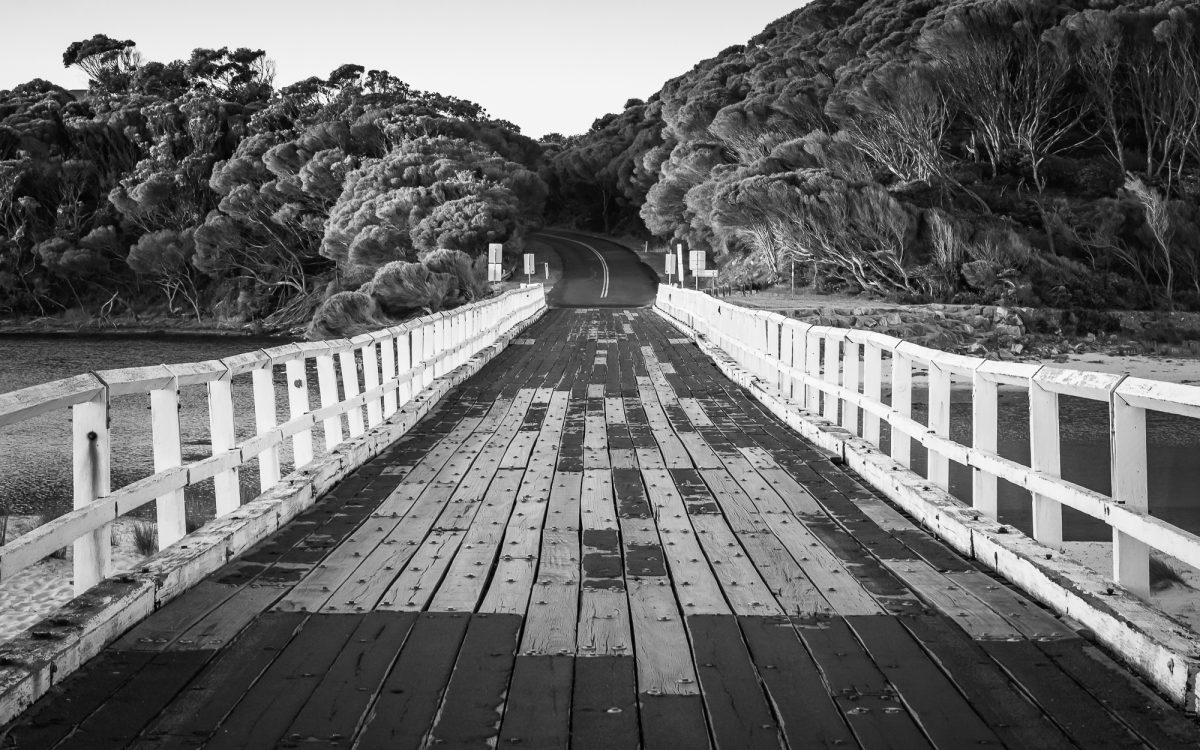
Cuttagee Bridge was built in 1892. Photo: David Rogers Photography.
Cuttagee Bridge was built in 1892 and is identified by the council as a heritage item in its Local Environmental Plan 2013. Council commissioned a full heritage assessment in 2021.
Professor Mackay said while the bridge had changed substantially over time, as timber bridges did, many of its important historic characteristics had been retained including being single-lane, timber, as well as its visual qualities and context as part of a coastal tourist road.
“It is part of a sequence of historic bridges, having that clattering noise as you cross it and having to pause to cross, is all part of the experience,” he said.
He said the restoration should be done in a way that is safe, functional and affordable, but also keeps its important heritage characteristics. “None of the three options does that,” Professor Mackay said. “Council is trying to assemble a puzzle with only three quarters of the pieces.”
He said council should have allowed its 2021 heritage assessment to guide the design parameters, rather than focus solely on a more functional engineering solution. “Option 1 is just a modern concrete bridge with applied timber decoration,” Professor Mackay said.
At a community forum about the bridge’s design options last month, council staff told residents the $15 million funding agreement between council and Transport for NSW was very specific and had very tight guidelines around performance standards that must be followed. However, the funding agreement has not been released to the public.
“If council wants to rely on that agreement in a community debate, its content should be shared otherwise there is no transparency. Verbal reports about secret documents have limited value in public discourse,” Professor Mackay said.
“There is a very good example of how to do this well in the nearby Wallaga Lake Bridge that has been rebuilt by Transport for NSW to meet modern requirements.”
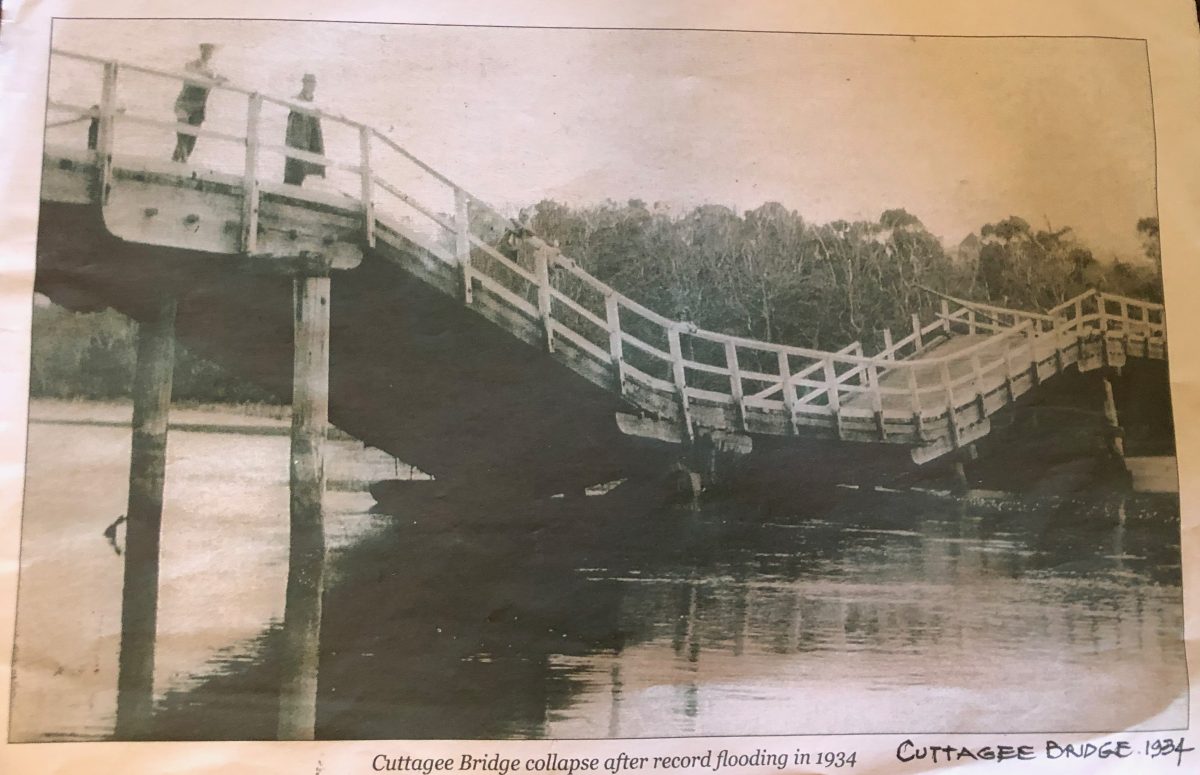
Cuttagee Bridge has been lengthened twice and repaired after two major flood events. Photo: Marion Williams.
Professor Mackay’s advice suggested that a conservation management plan, consistent with the Burra Charter of Australia ICOMOS, should have informed concept designs for a functional bridge while retaining heritage values.
“The three concept designs do not retain the bridge’s important heritage attributes and should not proceed as proposed,” the report stated.
Professor Mackay added that the Tathra-Bermagui Road was a scenic coastal road and not a major highway.
“It doesn’t have to be upgraded to take heavy trucks, nor to be two lanes,” he said. “Functional means it can carry a fire truck, but that doesn’t mean two lanes for industrial haulage.”
The Save the Cuttagee Bridge group called on council and its consultants to consider Professor Mackay’s report and intervene before the designs are developed further.
“It isn’t too late to produce a solution that reinstates heritage values as the central and guiding principle of the bridge project,” group spokesperson Sheena Boughen said. “Taking this step now will honour this iconic heritage asset and preserve an important source of economic and cultural benefit for our region, as well as respecting the wishes of the local community.”
“Council is a public authority and its own planning instrument has clear objectives supporting the conservation of heritage items,” Professor Mackay said.







